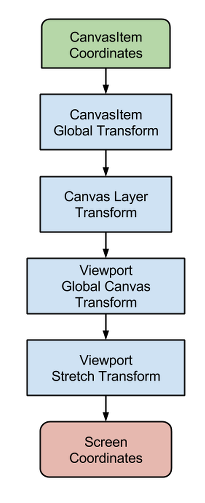Viewport and canvas transforms¶
Introduction¶
This tutorial is created after a topic that is a little dark for most users, and explains all the 2D transforms going on for nodes from the moment they draw their content locally to the time they are drawn into the screen.
Canvas transform¶
As mentioned in the previous tutorial, Canvas layers, every CanvasItem node (remember that Node2D and Control based nodes use CanvasItem as their common root) will reside in a Canvas Layer. Every canvas layer has a transform (translation, rotation, scale, etc.) that can be accessed as a Matrix32.
Also covered in the previous tutorial, nodes are drawn by default in Layer 0, in the built-in canvas. To put nodes in a different layer, a CanvasLayer node can be used.
Global canvas transform¶
Viewports also have a Global Canvas transform (also a Matrix32). This is the master transform and affects all individual Canvas Layer transforms. Generally this transform is not of much use, but is used in the CanvasItem Editor in Godot’s editor.
Stretch transform¶
Finally, viewports have a Stretch Transform, which is used when resizing or stretching the screen. This transform is used internally (as described in Multiple resolutions), but can also be manually set on each viewport.
Input events received in the MainLoop._input_event() callback are multiplied by this transform, but lack the ones above. To convert InputEvent coordinates to local CanvasItem coordinates, the CanvasItem.make_input_local() function was added for convenience.
Transform order¶
For a coordinate in CanvasItem local properties to become an actual screen coordinate, the following chain of transforms must be applied:

Transform functions¶
Obtaining each transform can be achieved with the following functions:
| Type | Transform |
|---|---|
| CanvasItem | CanvasItem.get_global_transform() |
| CanvasLayer | CanvasItem.get_canvas_transform() |
| CanvasLayer+GlobalCanvas+Stretch | CanvasItem.get_viewport_transform() |
Finally then, to convert a CanvasItem local coordinates to screen coordinates, just multiply in the following order:
var screen_coord = get_viewport_transform() + ( get_global_transform() + local_pos )
Keep in mind, however, that it is generally not desired to work with
screen coordinates. The recommended approach is to simply work in Canvas
coordinates (CanvasItem.get_global_transform()), to allow automatic
screen resolution resizing to work properly.
Feeding custom input events¶
It is often desired to feed custom input events to the scene tree. With the above knowledge, to correctly do this, it must be done the following way:
var local_pos = Vector2(10,20) # local to Control/Node2D
var ie = InputEvent()
ie.type = InputEvent.MOUSE_BUTTON
ie.button_index = BUTTON_LEFT
ie.pos = get_viewport_transform() + (get_global_transform() + local_pos)
get_tree().input_event(ie)